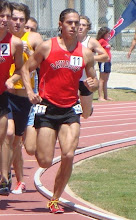My second day with Carlos and the Parkour School in Viña del Mar saw one of the highlights of my time in Chile. Kindergarten Parkour.
For those of you that might have just gotten a terrifying mental image of your 4-year old taking their bed-bouncing and shelf-climbing skills to terrifying levels, I’d like to clarify that Carlos is not teaching kindergarteners how to jump between buildings or vault over railings. His primary goal is to get the kids comfortable moving and running around, and teaching them to explore their environment in a safe way. The results are pretty impressive, and as I watched the kids chase Carlos through an “obstacle course” in the yard I realized how much he was actually teaching them. Watching 4-year-olds stand on the edge of the terrace and consider the drop beneath them (not much to adults, but to them, it was almost chin-height), I bit my lip as I anticipated the jarring, straight-legged and flatfooted jump that most children do at that age (and many adults still do years later). Instead, I was surprised to see them bend their knees as they hit the ground and absorb the shock with their entire bodies. While this wasn’t pre-meditated on their part, and I’m sure that they had no idea why they were doing it, it was clear that it was the direct result of weeks of games and gentle instruction by Carlos.
Since getting a group of kindergarteners to do drills and strengthening drills is nigh impossible, Carlos’s “lesson plans” turn these movements into games and fun activities. Colored paper has much the same effect on small children that “good” playground equipment or scaffolding has on traceurs, and it immediately made anything Carlos did infinitely more interesting to the kids. While most traceurs will grimace inwardly at the thought of a quadrupedal workout, the kids loved “playing animals” and really got into the “cat walk”, the “monkey walk”, and even the “elephant walk”. Watching the kids doing the movements made me think about how we naturally do most of these quadrupedal movements for years before we “grow up” and subsequently forget them.
Games like follow-the-leader encouraged the kids to explore their playground and to see it from different perspectives, and “I spy” games that differentiated between wood, plastic, and metal objects throughout the playground taught them about the different materials that made up their environment. It was fun to watch the lesson unfold, as each activity that Carlos did with the kids could be tied directly to a parkour training drill or exercise, although in retrospect I’m not sure whether this is a reflection of the training mentality of traceurs or of the basic instincts that we all have.
Here's a brief look at the class:
Unlike at the end of many of the parkour training sessions I’ve done, the kids had plenty of energy to climb on us and run around afterwards, but I realized that the important part was not the strength or conditioning that traceurs often seek. Instead, what counted was what the kids took away on a subconscious level. As a former camp counselor for 8 years, I know first-hand that many kids in today’s world have no idea how to jump, climb, or explore their environment in a safe manner. While it comes naturally to some kids eventually, these skills never develop in others, often leaving them afraid to explore or engage in activities that might involve these things. By having them start out with “baby steps” Carlos’s classes ensure that the kids learn the basics in a safe environment while also becoming more comfortable in their movements.
While this Kindergarten Parkour class is only being run in one school at the moment, there have been a number of other schools in the area that have expressed interest in the program so Carlos is hoping that he’ll be able to expand his list of clientele soon.
Subscribe to:
Post Comments (Atom)

.jpg)



Brilliant and perfect.
ReplyDelete